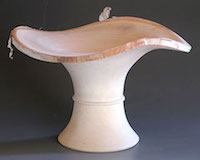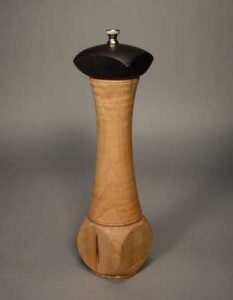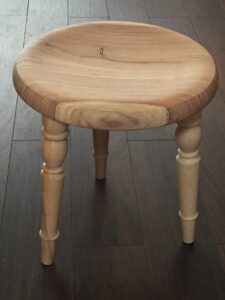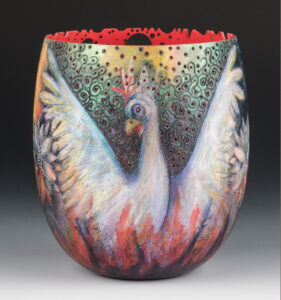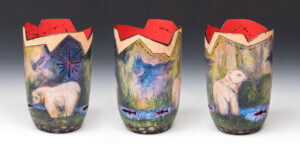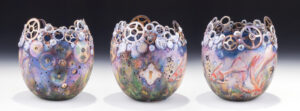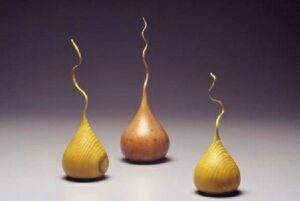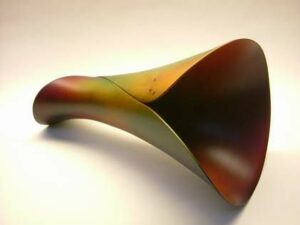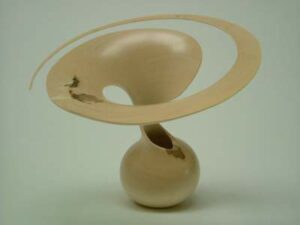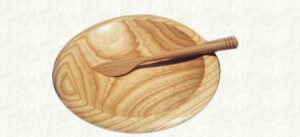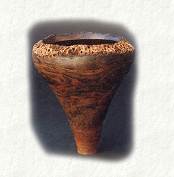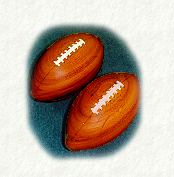2024 Demonstrators
| Stuart Batty | |
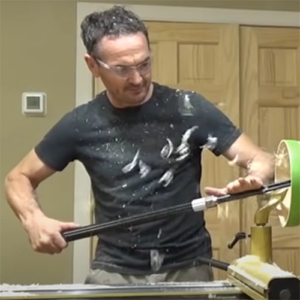 |
|
| Stuart is a third-generation woodturner, being a full-time production turner and teacher in his father’s studio at age 16. At 19, he started working for Craft Supplies in England, at the time the world’s largest supplier to woodturners. During his 6 years at Craft Supplies, he was the in-house woodturning teacher and demonstrator. He set up Craft Supplies’ frst sawmill and was in charge of their import business that sold more than 300 exotic woods around the world. Stuart also developed and tested woodturning tools for Robert Sorby, a Craft Supplies sister company. During the past 34 years, Stuart has taught more than 3,000 amateur and professional woodturners. He has demonstrated and taught in 12 countries and for more than 180 AAW chapters throughout the US. Stuart’s style of work is greatly influenced by his background as a spindle turner with precise cuts and sharp detail. He uses very simple tools and tool shapes to create his pieces. His work is pure lathe work, with no carving or surface texturing. Stuart’s artwork has been sold through prestigious galleries across Europe and the US. He also has artwork displayed in the permanent White House collection. Stuart believes we have only skimmed the surface of the potential of a wood lathe. With production woodturning as his background, his foundation in woodturning helped him perfect the push cut style and other useful techniques, such as negative rake scraping
|
|
Stuart Batty Perfecting the Art of Cutting |
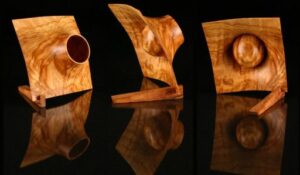 |
| Stuart will show how to perfect cuts with the three main gouge types – bowl, spindle, roughing – and chisels, including skews, parting tools, and beading tools. Included will be the simple way to freehand grind each of the tools, allowing it to perform at its best for all wood types. He will break down the cuts in to simple movements that everyone can learn – how the right hand controls the tool, the left hand assists, and the body movements that make cutting easier and repeatable. | |
Bowl Turning with the 40/40 Grind |
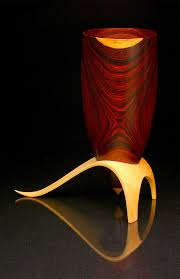 |
| Bowl Turning with the 40/40 Grind The 40° bevel and 40° straight swept-back wings on a bowl gouge make this the most versatile tool you can own. This demo will show you how to freehand grind the gouge on a platform and the motions used make repeatable cuts with little physical effort and no torn grain. Stuart will show how this gouge is controlled for both spindle and bowl turning. | |
Seven Set-up Fundamentals |
 |
| Every cut requires correct setup, and there are 7 very important setup rules that eliminate the variables in woodturning. Following these rules makes turning safer, easier, and more fun. | |
| Alan Lacer | |
 |
|
| Alan has been involved in woodturning for over forty years as a turner, teacher, writer, exhibition coordinator, demonstrator and expert witness. Alan has been an instructor and demonstrator, working in all fifty states and six foreign countries. His published writings—upwards of 150—cover a wide spectrum of woodturning from historical and cultural, technical and specific projects. His specialties include the skew chisel, sharpening techniques, finishing, lidded boxes and making/using hook tools. In 1999 he was awarded the Honorary Member Award for that year from the American Association of Woodturners for his contributions to the field. He has appeared on PBS in the series, Woodturning Workshop and on the DYI channel. | 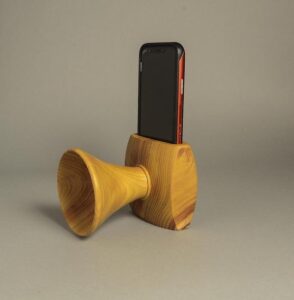
|
| Keith Gotschall | |
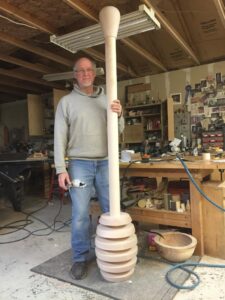 |
|
| In a nutshell, I build things. | |
|
My background is in furniture design and building, I have expanded that to include woodturning, which has pretty much taken over much of my working day. I also have a penchant for stone sculpting. I work from my own workshop on a commission basis. I do offer wholesale options to genuine retail outlets. I am a Craftsman. That statement says a lot for me. Yes, I am an artist too, but on the most familiar scale I am a craftsman. I make furniture. I wood turn both functional and decorative items. I teach wood turning. I sculpt both wood and stone. My intent as the maker is important to me. I try to bring this focus, this same feeling and set of skills to everything I do throughout the day. I make things well, with a thought toward good design and pleasing use. I try to make things that will last, that will have a life of their own after I am gone. Sometimes whimsical, often practical, but always honest. |
|
I will be demonstrating 3 items at the 2024 Symposium |
|
| A Three Legged Stool
In this demo I lay out the basic stool seat and show how to drill at the appropriate angles. I then turn the seat using a 4 jaw chuck. I then show how to lay out a leg using the minimum of measuring tools and explain how I go about replication. Demonstrating beads, coves and straight cuts to make a simple pattern, I then show how easily it can be replicated quickly and accurately. The audience will learn elements of design that will make replicating the legs of the stool very easy. Discussion of design will also show how to avoid common pitfalls, and ways around possible flaws. Techniques shown are simple, but effective in both spindle turning and bowl turning. Discussion with the audience will cover critique, furniture styles, possible options for further exploration and wood selection. |
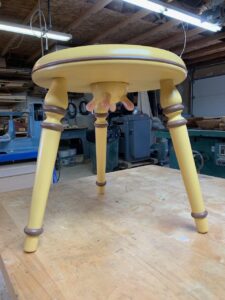
g |
| Lidded bowl/tortilla warmer
Key points in this demo will be wood selection, steps necessary for success, technique and design. The demo will cover the use of the 4 jaw chuck in contraction and expansion modes. Proper tool use and design considerations will also be covered. The bowl will be flat bottomed, and decorating the base and interior of lid will be shown, making beads etc. in a cross grain orientation. Design considerations will explain the methods of work, and options will be discussed. Spindle and bowl gouges, scrapers and measuring devices will all be covered. Attendees will learn how to use the 4 jaw chuck to great advantage, both in contraction and expansion modes. How to cut through the grain correctly will be a focus of this demo. Correct tool use will demonstrate how easily shapes may be produced, making crisp detail that needs a minimum of sanding. Efficient gouge use, as well as the use of home-modified scrapers will be shown. They will also see how the design is informed by grain direction, and how that plays an important part in overall “feel” of the piece. |
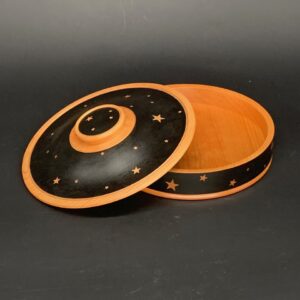 |
| Off Center Platter
In this demo the basics of platter making will be shown, as well as the special considerations for going off center. Safety, of course, will be a primary factor in making this project. By using the 4 jaw chuck as a screw chuck and in the expansion mode, an easy way to make this platter with an uneven rim will be shown. Design considerations will be discussed with the audience, and feedback will be encouraged. This is a fun demo that should spark some new ideas of your own. In the demo, different possibilities will be discussed, what slight changes will produce in the end result. Difficulties in turning off center will be explained, and how correct technique can minimize these aspects. Also, along the way, how to cut clean beads in a cross grain orientation will be shown, and what details work, and which don’t work as well. Decorating the off center rim will be shown and other possibilities discussed. |
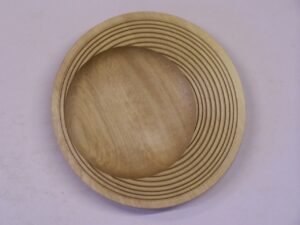 |
More Background |
|
| Salad bowls and Utilitarian work
My normal utility work is made from hard wood species that are suitable for everyday use. Hard wearing but not so brittle that they crack, every effort is made to ensure a long lasting product that will be passed down for generations. All work of this kind is finished with a food safe finish and buffed with bees wax. A simple application of walnut oil or mineral oil will keep your bowl looking it's best. In my kitchen, bowls are washed with soap and water, then put in the dish rack to dry. I rarely oil them after the initial finishing process and after years of use they still look great. Keep wooden bowls out of direct sun, and never fill them with water to soak or let them float in water as this may crack any wooden ware. Though the refrigerator seems to be fine, do keep wooden ware out of the microwave and dishwasher. Though most often associated with salad, these bowls are great for many things. Serving hot pasta, popcorn, breads or rice dishes are some of my favorites. The insulating properties of wood seems to keep food hot longer, while keeping fingers and hands from becoming too warm. |
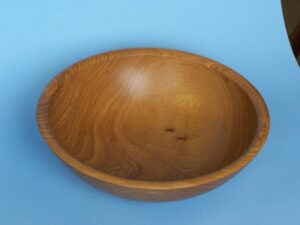 |
|
Born in Chicago, Ill. in 1962, Keith lived in the midwest until 1980. In 1981 he moved to Boulder Co. and began a career in wood working. After an informal apprenticeship in several different wood shops Keith started his own design and fabrication studio in 1989. Building furniture mostly on a commission basis, Keith also stretched his talents by doing the occasional speculative piece that would be shown in art galleries or in fine art shows. He has won numerous awards around Colorado |
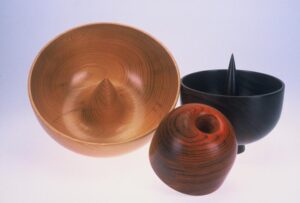 |
|
Keith is also a sculptor of stone. Using marble and alabaster from the area Keith has also won many awards for his sculpture. His work tends to be of a figurative nature, often abstracting the human form. In 1998 Keith visited with a local wood turning friend who let him play around with some of his tools and showed him some of the more modern theory behind wood turning. Remembering that the lathe was the reason he became interested in woodworking in the first place, Keith was keen to pursue wood turning from that moment on. After studying with recognized masters like Richard Raffan, Mike Mahoney, and Stuart Batty, he now makes work for galleries and private clients. |
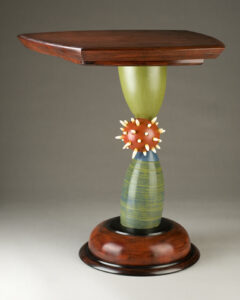 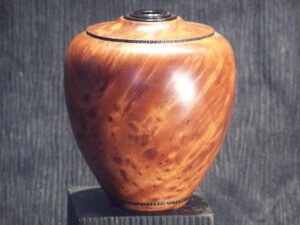 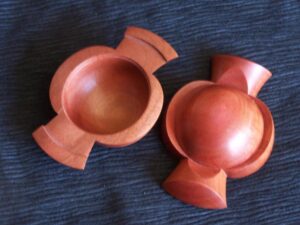 |
| Keith was the artist featured in a Discovery channel show hosted by Lynette Jennings. (episode 142) He has also been featured demonstrator at the prestigious BYU Woodturning Symposium in Provo Utah in 2002 and 2008. A featured demonstrator for the 2005 AAW symposium in Kansas , Portland Oregon in 2007 , Hartford CT in 2010, Tampa FL in 2013, Again in Portland in 2018. He was asked to present for the impressive Australian symposium in 2018, and thoroughly enjoyed a visit down under! A visit to Saratoga Springs for the Totally Turning symposium was a first visit in 2019. He has taught classes at the John C Campbell folk school in North Carolina, Craft Supply woodturning school in Utah, the Anderson Ranch in Colorado, and also the Center for Furniture Craftsmanship in Maine. Keith continues to teach and demonstrate for many different clubs and organizations around the country as well. He has contributed to the AAW magazine American Woodturner, Woodturning Design, and the British magazine Woodturning. As well he has been asked to jury several competition/exhibitions of woodturning and furniture. Keith's work was shown at the 2004 BYU art museum show and the accompanying book "Beneath the Bark". His work is also found in the book "500 Bowls".
He now lives in the small mountain community of Salida,in the Rocky Mountains of Colorado. His home and studio are at the base of the continental divide and he shares them with his wife Catherine. An avid rock climber, hiker, and moto rider, Keith is often found outdoors enjoying Colorados rugged beauty. Copyright 2016 Keith Gotschall. All rights reserved. |
|
| Carol Hall | |
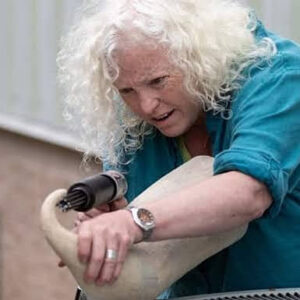 |
|
| "Being an artist is not a choice for me, it is a burning drive. I need to create something, everyday." | |
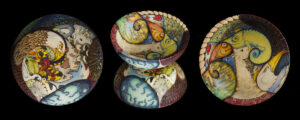 |
|
| Carol Hall is an award winning artist who creates embellished woodturnings that push the envelope of color, narrative and surface treatment. Being an artist is not a choice for her, it is a burning drive. She strives to create new work, everyday.
Carol learned woodturning in Pennsylvania and quickly discovered that some of the country's best turners lived close. By joining several local AAW clubs where members share their skills, she honed her own techniques and was asked to collaborate with some truly dynamic turners. She embellishes wood surfaces with paint, colored pencils, pyrography and carving. Carol also creates a body of work with her husband and fellow artist, Mark Hall. Several of her wood specific techniques are the result of that focus and study. She now shares them in demos, nationally. Her “RUSH” philosophy (Raise the Grain, Use Wet Water, Shellac, Heat Lamp) is emblematic of the thought that goes into her surface preparation, as well as her artistic philosophy. By encouraging efficient and well prepared work, Carol believes artists are able to free-up their creativity, create a body of work, and have a more satisfying artistic experience. Her demos focus on hacks that save you time, allow for mistakes and corrections, and provide superior results. Carol is a founding board member of the Mid Atlantic Woodturning Symposium, a member of Woman in Turning, and was a national Demonstrator and Panelist for the AAW Symposiums. She has participated in Artist Cooperatives, including Echo Lake and EMMA. Carol's collaborative work “27 Animals, 3 Artists” won a 2016 Niche Award. There is a clear design thread that connects all of Carol’s art. She may find delight in a wavy grain pattern in wood and a slash of light on a form. For Carol Hall, the medium is not the message, but rather an unlimited means of exploration. |
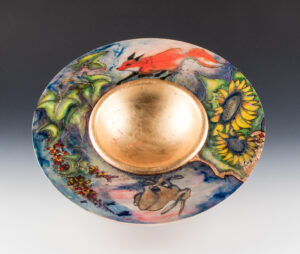
|
| Mark Hancock | ||
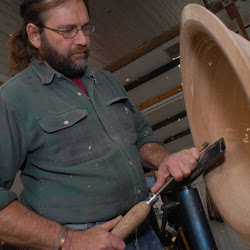 |
||
| The turning point in my life (sorry no pun intended) came in 1989; relocation to Yorkshire with the firm I was working for as an accountant or redundancy and a new career direction? I choose the latter and with the aid of the Government Employment Training scheme began training with a professional turner. During this period I took second prize for turning in the National Eisteddfod of Wales; first prize went to my tutor!
I began by specialising in high quality turned decorative and functional bowls and individual vessels using simple designs to bring out the natural beauty and variations in colour, texture and figuring of local timbers. As each piece of timber is an unknown quantity before being turned I worked with the wood. A cliché maybe, but it is a relationship that develops between initial ideas for a piece and inspiration drawn from the timber as it reveals itself. My work is now more an exploration of line and form than an effort at an artistic statement and it continues to amaze me how each minute refinement of a curve can alter the character of a piece. I strive to achieve a perfect form - or at least something a little closer to it than anything I've done before. There is always further to go. This originally evolved to a series of work with hollow vessels based around a vase design with exaggerated rims that are partly removed and shaped. The inspiration for these came from the image of a falling drop of water, hence the Drop Series, with the incising giving each piece a sense of movement. The use of sycamore allows the form to take prominence. This series of work became my trademark work. The Foreign & Commonwealth Office commissioned a piece from this series of work as gifts for the Foreign Ministers attending the Cardiff European Summit in 1998 hosted by the UK as President. In 2003 I was invited to participate in an eight week residency in Philadelphia, the International Turning Exchange (ITE), working with others selected from the international community to focus on advanced technical innovations, aesthetics and techniques. This experience had a profound affect and changed how I approached my work. Inspiration was drawn from other mediums and disciplines from outside the world of turning leading to more sculptural forms. The use of pale timbers and colouring techniques made the form all the more important rather than how it was produced. Wood is still my choice of material to work with and initially turning the method of creating the form but it is not always obvious. My move in 2005 to a larger studio in Worcestershire has helped this progression in my work with more space and light to aid this creative process. Where the work will go next I do not know but that makes it all the more exciting for me. |
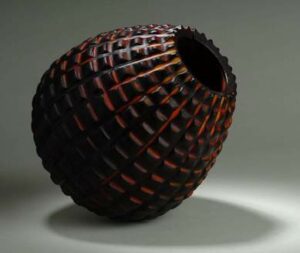
|
|
| Nick Cook | |
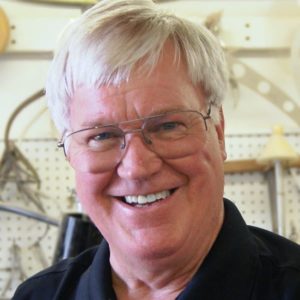 |
|
| Nationally known woodturner, Nick Cook lives in Marietta, Georgia, where he owns and operates his studio. He grew up around his father's woodworking equipment and became interested in the art of woodturning in the mid-70s after several years in furniture design and manufacture.
A founding member of the American Association of Woodturners, Nick served six years on the board of directors, including one as vice president. In addition to creating one-of-a-kind pieces and his staple gift items, Nick teaches and lectures on various woodturning topics, has written articles for several woodworking magazines, and produced two woodturning videos. The primary materials that he now uses are maple, cocobolo, and tagua nuts. He employs a variety of woods, both domestic and exotic for his one-of-a-kind pieces. Nick's work is marketed in gift shops and galleries from coast to coast and is included in numerous corporate and private collections. You can also find Nick selling his pieces at craft fairs in the Southeast. Take a look at Nick's Formal Bio for details about galleries and exhibitions with his work, seminars and workshops he has presented, articles he has published, and more. |
|
